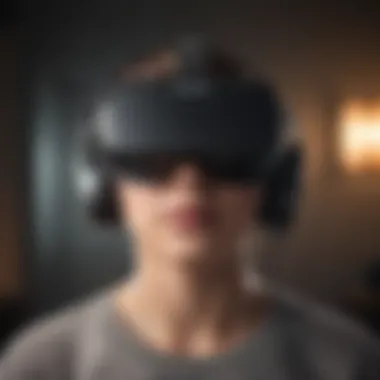Best VR Headset for Family: Find the Perfect Fit


Intro
Virtual reality (VR) technology has found its place in the contemporary household, unlocking a novel playground for adventure and learning. Families now explore this immersive technology, requiring careful selection of the suitable VR headset for a shared experience. Emphasizing user-friendliness, safety features, and engaging content, it is crucial to delve into the right options that cater to all family members. This detailed guide focuses on the dynamics of family use, enabling readers to make informed decisions tailored for diverse age groups.
Game Feature Spotlight
Virtual reality gaming offers unique possibilities that go beyond traditional gaming. Appropriate headsets enhance these experiences, making them enjoyable yet suitable for family interactions. Families needing quality time can greatly benefit from understanding the core components of various games available through these platforms.
Unique Gameplay Mechanics
Many VR games adopt innovative mechanisms designed for optimum interactivity. The gameplay can vary across different VR titles, from immersive simulations crafting realistic environments to fun educational setups encouraging skill development. These aspects can entertain children while educating them, culminating in an experience suitable for varied ages. For example, titles like Beat Saber encourage physical activity while honing rhythm skills, making them a popular family favorite.
Art Style and Design
Art style significantly influences a game’s appeal. A vibrant, engaging style attracts younger family members, while more sophisticated aesthetics can cater to older audiences. Having visual diversity supports a richer selection of games, ensuring there is something enjoyable for everyone. Games such as Job Simulator not only offer clever mechanics but also employ a playful visual approach, drawing players into an experience which they all can enjoy together.
Storyline and Characters
The narrative elements of a game lay the foundation for a gripping experience. Stories featuring relatable characters foster a sense of connection within a family. Titles like Parents Demand Procedural Rules Remain succeed in providing grounding elements that families can rally around. The addtional benefit lies in the possibility of discussing these narratives as a family, promoting valuable interactions among members.
In-Demand Content for Families
VR also has playable content meant for group interaction, enhancing the overall viewing experience during family evenings. Many platforms offer collaborative or competitive modes. Having experiences that provide opportunities for cooperative play fosters boning while engaging different age groups in enticing challenges.
Foreword to Family VR Experiences
In recent years, virtual reality (VR) has emerged as a significant medium of entertainment and education. It has transformed how families interact with technology and with each other. Understanding family VR experiences becomes crucial when exploring the world of VR headsets. Families can engage together, enhancing bonding through shared enjoyment of virtual environments. This introduction emphasizes the multifaceted role VR can play in family dynamics and touches on various benefits that cater to different needs within a home.
One core element is the ability to immerse multiple users in collaborative activities. Experiencing virtual worlds together can promote teamwork and communication skills among family members. Whether it is solving puzzles, engaging in adventure games, or learning new skills, these activities foster relationships in an enjoyable setting. As each family member joins the experience, unique perspectives and approaches emerge, leading to enriched interactions and shared memories.
Moreover, families interested in VR must consider not just the entertainment factor but also educational opportunities. Many VR applications facilitate learning experiences that make subjects like history, science, and technology more accessible and enjoyable for all age groups. These varied content offerings provide an inclusive educational platform, bridging gaps between traditional learning methods and modern technology.
When families assess VR experiences, they should also factor in age variation. It's vital to understand which VR systems cater to diverse cognitive and physical capabilities typical in a family setup. Sound knowledge of age appropriateness ensures all members feel engaged and safe.
In summary, it is essential to recognize the transformative impact of family VR experiences. The interplay of entertainment, education, and inclusivity marks them as a valuable component of modern family life. Such an understanding supports informed decisions when selecting a VR headset that can fulfill the varied interests and capabilities of family members.
Understanding Virtual Reality Technology
Virtual reality (VR) technology has transformed entertainment and education, presenting a unique realm of immersive experiences. The importance of understanding VR technology in this guide is crucial for selecting family-friendly headsets. By grasping the core principles of VR, families can ensure a meaningfull experience while fufilling the needs of diverse age group.
VR technology develops an environment that enables users to interact within a simulated world. This simulation can be either computer-generated or derived from real-world images. The key elements involved in VR include:
- Head Tracking: Accurate head tracking is vital for realism. This allows the offender to explore environments naturally by moving their heads. Families should consider how well head tracking functions when comparing headsets.
- Motion Controllers: Many VR setups offer motion controllers, enhancing interactivity. Families can connect more deeply with content, making game play or learning experiences more engaging, especially for younger users.
- Sound: 3D spatial audio is another core feature that amplifies immersion. It adds a layer of realism through sound design. The audio helps users orient themselves within a virtual space. This element particularly enhances shared family experiences.
VR technology's interactive aspect benefits users significantly, allowing adjustments based on user movements. This reliability promotes enjoyment over frustration, especially considering varying tech-savviness among family members.
Immersive VR experiences require a balance: Quality technology doesn’t overshadow the family’s enjoyment.
Benefits of understanding VR technology also encompass:
- Adaptation for Different Age Criteria: Certain headsets align better with specific age groups. Knowledge about these pairings helps streamline choosing appropriate gear.
- Evaluating Content Quality: Understanding what VR can offer in terms of software aids families in nurturing interests, from gaming to educational apps.
- Technological Comfort: Familiarity with VR setups aids technical comfort for family members who may be less inclined to embrace new tech. The reduction of anxiety related to tech interaction promotes greater participation.
As families explore various headsets, comprehension of these concepts will deepen informed decision-making. Recognizing how both hardware and software contribute to the overall VR experience will ensure a rewarding and enriching family entertainment option.
Key Considerations for Family-Friendly VR Headsets
In selecting a virtual reality headset suitable for family members, several key factors must be taken into account. The unique dynamics of families can really affect how these headsets are used and appreciated. Families often bring together various age groups and all have different needs and experiences. Therefore, it is vital to understand a few important aspects. A headset that doesn’t align with family needs may lead to undesired experiences or even outcomes. So let us explore what makes a VR headset ideal for a family environment.
Age Appropriateness
Choosing the right headset for various age groups can feel complicated. Different VR products have distinct age viewing requirements. Headsets must cater to users as young as six years old, and some adults may use them too. Serious damage could occur if VR headsets lack recommendations for particular ages. It might restrict fun for some or expose younger users to unsuitable content. Thus, looking into guidelines set by each headset manufacturer** is very essential.


Ease of Use
User-friendliness should be a dominant factor in the decision-making process. Different users will have different skill levels in navigating games or apps within VR. Family members may range from tech-savvy to outright novices, making ease of incorporation critical. A VR headset with intuitive menus and simple setup will make for a far more enjoyable experience for the whole family. Complicated setup processes can be a source of frustration, which can ruin fun moments that could be created within families. Therefore, search for headsets designed with minimal user intervention.
Safety and Health Concerns
As VR becomes a hobby amid families, issues arise about safety and overall health. Physical strain, reliance on screens, and other related health compenstrual aspects must be acknowledged. Families should prioritize headsets that emphasize safety features, including cushioning, adjustable straps, and guidance for time limits on games. VR headsets also raise questions of digital health, such as exposure to inappropriate content. It’s crucial to lay out boundaries and features to help monitor, manage, and respond to health or use issues that arise.
“Prioritize safety in a virtual reality environment, just as you would in the real world.”
Content Variety and Availability
For any head set's soul, a varied content ecosystem is necessary. VR pages for families should suit numerous interests: educational apps, games, simulations, and experiences. Enthralling selection keeps every family member engaged and less tempted leave disabled headsets collecting dust. Apart from that, headsets with established app stores or the ability to purchase and download diverse resources helps families value use well. Thus, individuals must pay attention on supported formats and app availability, ensuring suitable finds for everyone in the family.
Top VR Headsets for Family Use
Choosing the right VR headset for family experiences is vital. Each family member, from young children to adults, must find it usable and engaging. A proper headset brings many benefits, facilitating not only entertainment but also learning opportunities. Accessibility, engagement of different content, safety features, these aspects greatly influence choices.
It's also important to note the balance between performance and ease of use. Families benefit when a headset can offer immersive experiences without being overwhelming. Understanding these dynamics aids in making informed choices for a fulfilling experience.
Quest 2: A Versatile Option
Specifications
The Quest 2 offers impressive case of specifications for VR. It has a high-resolution display at 1832 x 1920 per eye and a powerful Snapdragon XR2 processor. This combination ensures clear visuals and smooth gameplay. Because of its standalone design, no additional hardware is needed, which contribution as a solid option for families who want to start vr gaming without proper induce.
Its wireless feature allows for freedom of movement, an important element when children engage in content that includes motion. The headset also has adjustable straps, permitting comfort for users of various head sizes.
Pros and Cons
The benefits of the Quest 2 include affordability and an extensive game library. The recent additions and updates mean that families will constantly find new offerings to engage everyone. However, some drawbacks exist. Extended use can lead to discomfort, and the device sometimes requires a Facebook account for full functionality, which may concern privacy-aware families.
Best Uses for Families
The Quest 2 shines in multi-user settings. Educational apps are available as aids for kids during learning sessions. There are also several multiplayer games for family fun, engaging toddlers and teens. Its uses range from educational experiences to gaming sessions that families can bond over. The convenience it provides makes it a popular choice in family spaces.
PlayStation VR: A Console Integration
Specifications
The PlayStation VR is tailored for users already invested in Sony's gaming ecosystem. With a resolution of 1920 x 1080, it ensures good video quality. Its compatibility with PlayStation consoles mean that it makes great use of already owned games. But it does require a connection for the PlayStation to maximize is capabilities during family use.
Pros and Cons
The key feature stems from its library, which contains many popular titles, particularly those suitable for ages vary from casual to intense gaming. As a console-based system, it's easy to access multiple controllers for swift setup in multiple users. Yet, hints of cons are there user has to consider. The system does not boast standalone capability, limiting some families seeking total mobility in their gaming experience.
Best Uses for Families
With its rich catalog, cooperative games are enjoyed by family members together. It is especially effective for mature products oriented to a bit older teens or adults. There are educational apps, including historical experiences too. As for regulatory ability, overseeing content will fit parents wanting to monitor kids’ access.
HTC Vive Flow: Portability Meets VR
Specifications
The HTC Vive Flow stands out for its portability. Weighing only 189 grams makes it easy to wear for extended sessions without distress. Offering a resolution of 1600 x 1600 per eye, sharp visuals aid to engaging experiences while being lightweight. Its folding structure aids in taking it on trips or out of home.
Pros and Cons
Being lightweight is a boon, as it accommodate use extremely observed purposes like meditation or casual gaming throughout family gathering. However and importantly, the performance measures are lesser than that of heavier, high-powered devices, making it better for family interactions than immersive experiences. Some parents might see this as limiting on exciting times involved.
Best Uses for Families


HTC Vive Flow is perfect for easing into VR space. Families can engage in light environmental creations, driving communication along with educational apps built to help relaxation or communication with disabilities and so forth. Its accessibility ensures user can share wider experience or get alone time each without heavy dragging safety concerns.
Valve Index: Premium Performance
Specifications
Valve Index is known for its high-end performance. The headset features a wide field of view and can go up to a resolution of 1440 x 1600 per eye. The specifications cater perfectly for users interested in serious gaming within families logged as enthusiasts. Because it requires a PC, added power goes influencer.
Pros and Cons
The smooth refresh rate of 120Hz or even 144Hz appeals a lot for clear view across experiences. Among households placing authenticity foremost, those looking to maximize will find sequential highs complex scenes. Nonetheless, substantial investment need makes some turn away, and bulkiness can be restriction for some families.
Best Uses for Families
Experiencing an adventure game together in family volumes appreciatively paves a fantastic bonding opportunity. Adjustability in catering make Valve Index adaptable features for teens while remaining pull on levels for adult family fans. This setup earns hair's margin prediction fewer total members might maximizing enjoyment while enjoying varying games from streams too.
Families should pay attention to individual needs in terms of suitability and experiences covered.
Comparative Analysis of the Leading VR Headsets
In the landscape of virtual reality, selecting the right headset for family use involves a meticulous evaluation of various products. The comparative analysis serves an essential purpose of discerning subtle yet meaningful differences between headsets. Understanding these distinctions is invaluable as it allows families to identify key attributes concerning performance, usability, and content engagement tailored specifically to their needs.
This section focuses on critical comparative elements that can influence a family’s overall VR experience. By highlighting individual headset capabilities and operational nuances, families can make an informed decision about which VR system integrates seamlessly into their lifestyle.
Performance Metrics Comparison
Performance metrics define how effectively a headset functions while in use. Key specifications include resolution, refresh rate, and field of view. These elements significantly affect immersion and overall play experience for users of varied ages. For example, the quest 2 has a resolution of 1832 x 1920 per eye which portrays excellent clarity during gameplay.
- Resolution: Higher resolutions provide clearer images, reducing the screen-door effect and elevating visual fidelity.
- Refresh Rate: A refresh rate of 90Hz or higher can make graphics appear more fluid, thus enhancing comfort and reducing motion sickness.
- Field of View: A wider field of view allows users to perceive more of the environment, facilitating greater engagement and realism.
Understanding these specifications not only aids in making a selection but also prepares families for discussions about optimizing performance through other means such as configuration settings.
Usability Across Age Groups
Usability scrutinizes how accessible and manageable a headset is across different age brackets within a family. Factors pertinent to this evaluation include weight, comfort, and the learning curve associated with using each device. Each headset offers distinct features aimed at optimizing usability:
- Weight: Lighter headsets are typically less cumbersome for prolonged use, making them appropriate for younger users who may struggle with heavier devices.
- Ease of Setup: The more straightforward the initial setup, the quicker a family can dive into the experience. Devices like PlayStation VR come with clear instructions, appealing to less tech-savvy users.
- Control Mechanics: Intuitive controllers further enhance usability, addressing various user skills and preferences. Modifiable controls on devices can cater to members of diverse gaming experience.
In this segment, it becomes apparent that suitability plays a major role. Families with younger children may prioritize easy-to-use models that support a non-technical setup and fast engagement.
Content Engagement Levels
Content availability directly correlates with how much enjoyment families derive from VR. A breadth of experiences, such as interactive games and educational programs, can greatly enhance overall engagement within the household.
Distinctions among headset content libraries are noteworthy:
- Diversity of Content: A wide-ranging library guarantees that everyone in the family finds something appealing; the Quest 2, for instance, boasts of rich game selection, VR experiences, and educational tools.
- Age-rated Content: Ensuring appropriate content for different ages is imperative for maintaining a safe digital environment. Understanding platform limitations and parental controls can guide successful content engagement for all, ensuring younger users are shielded from inappropriate materials.
- Frequent Updates: Regular software support enhances longevity and keeps content practices fresh. Valve Index notably boasts continuous support which fosters community feedback for new games.
In evaluating and comparing engagement levels, families can derive greater satisfaction from their VR systems, catalyzing shared experiences over solitary ones.
The comparative process undertaken allows family buyers to refine perspectives on vr headset features that resonate most with their needs. Families will ascertain essential aspects like performance and usability frameworks that seek to bring people together across generations. A detailed approach on comparative analysis aids in forming an educated decision, steering families towards selections offering greater cohesion during VR experiences.
Setting Up VR for Family Use
Setting up virtual reality (VR) for family use encompasses both the physical environment and the user processes involved. Ensuring that the setup is practical, safe, and engaging greatly enhances the experience for all family members. This phase affects how individuals interact with the technology, making it crucial for meaningful use alongside entertainment.
Space Requirements and Setup
The first step in setting up a VR system is evaluating the available space. VR experiences can be immersive and require sufficient room for users to move freely without risk of collisions. Ideal setups allow for at least 6.5 by 6.5 feet of play space. However, wider areas provide flexibility for various activities.
When determining the right space, consider these aspects:


- Clearing the Area: Ensure the play space is free of furniture or obstacles.
- Floor Surface: A non-slip surface reduces the possibility of falls during VR use.
- Ceiling Height: Higher ceilings discourage accidental head bumps.
The arrangement should create a clear boundary that delineates the virtual play area, aiding in focused use. Use visually significant markers or barriers to alert users when they approach the edges of the play space.
Furthermore, consider the range of movement for different VR activities. Some experiences require physical movement, while others may involve static viewing. Thus, flexibility in arranging the setup helps accommodate diverse VR content.
User Setup Guide
Once the physical space is ready, setting up users for optimal experiences follows. Here are main factors to guide family members as they join the fun:
- Initial Calibration: Each headset typically goes through an initial calibration process, where the user selects their boundary space. Make sure to follow manufacturer instructions carefully.
- User Comfort: Ensuring all headset adjustments are made for comfort can prevent issues such as headaches or discomfort. Adjust visual settings for clarity and head strap fit securely.
- Orientation Training: Teach everyone the basic controls before diving in. New users may benefit from a guided orientation, highlighting essential actions.
- Supervised Access: Younger family members may need supervision during use. This helps prevent misuse and encourages responsible interactions while allowing engagement with age-appropriate content.
The right environment and user setup lead to more satisfying family moments in VR, enhancing both fun and engagement with content.
Potential Risks and Mitigation Strategies
Incorporating Virtual Reality into family life can be immense fun and potentially transformative. However, it also introduces several risks that must be understood and managed. Addressing these risks can provide a safer VR environment and maximizing its benefits. This section covers two main areas of concern: physical health risks and digital safety. Each plays a crucial role in how families experience and engage with virtual worlds. Identifying these concerns offers better strategies to mitigate them.
Physical Health Risks
Virtual Reality can lead to a range of physical health issues, especially when used excessively. Common concerns include:
- Motion Sickness: Many users experience nausea when the VR environment differs from their physical sensations. This effect usually occurs due to lag, poor graphics, or rapid movements in virtual space. Recommendations include starting with short sessions and using headsets that minimize latency.
- Eye Strain: Extended use of VR can lead to discomfort, eye fatigue, or blurred vision. VR headsets induce a unique visual demand. Users are advised to take breaks every twenty minutes, focusing on distant objects to relieve eye strain.
- Disorientation and Falls: Users often become disoriented within a virtual experience, which can result in falls or bumps. Setting up physical boundaries within the play area can help reduce this risk. Users should clear space of hazards to create a safer environment.
Mitigation Strategies for Physical Risks
- Encourage healthy time limits to combat excessive use.
- Invest in high-quality headsets with lower motion sickness rates.
- Inform users on how to calibrate the headset effectively.
Digital Safety and Privacy
As engaging and immersive as VR can be, family safety doesn't stop at physical risks. Digital safety concerns raise questions about privacy and the appropriate use of technology. Relevant points include:
- Invasive Data Collection: Many VR platforms collect user data, possibly causing privacy concerns. Research what data the chosen headset collects and understand how it is used.
- Online Interactions: With many VR experiences supporting online multiplayer functions, children can easily come into contact with strangers. It is vital to educate family members on safe online behavior regarding who they interact with.
Mitigation Strategies for Digital Safety
- Adjust privacy settings to limit data collection as much as possible.
- Monitor online interactions and establish clear guidelines for children on acceptable behaviors.
Future Trends in Family VR
As the virtual reality landscape continues to evolve, understanding future trends becomes instrumental for families considering the adoption of this technology. With the rapid advancement of VR technology, families can expect even more engaging experiences thanks to innovations that cater specifically to family use. This section will touch upon two critical areas: the emergence of new technologies influencing family VR and the potential changes in family interactions that these advancements may bring.
Emerging Technologies
Emerging technologies in VR are reshaping the possibilities for family experiences. Developments such as improved head-mounted displays, wireless connectivity, and enhanced tracking, contribute to a more immersive encounter. Noteworthy aspects include:
- Hand Tracking: This functionality allows users to navigate VR environments using their hands, eliminating the need for controllers, which could help younger children navigate safely.
- Mixed Reality Capabilities: Combining VR with augmented reality can create shared interactions, where onlookers can also partake in VR experiences.
- AI Integration: AI-driven content promises personalized experiences by adapting to user preferences. For example, content targeting various age groups can provide something enjoyable for everyone in the family.
These technologies not only enhance user engagement but also promote collaboration among family members.
Potential Impact on Family Interactions
Introducing virtual reality can significantly influence dynamics within families. These changes might manifest in helpful and challenging manners. Important influences can include:
- Shared Experiences: VR creates opportunities for families to partake in simultaneous activities, thus fostering collaboration and bonding. For instance, families can explore distant wonders or simply play games together in immersive environments, facilitating moments of unity.
- Education and Learning: With resources such as educational VR content, families can utilize VR for learning purposes. Whether it’s exploring historical sites or simulating lab experiments, families have the opportunity to engage in discussions and learning together.
- Mental Well-Being: VR can aid in relaxation and stress relief. Family members might engage in soothing VR environments together, promoting overall mental health benefits within the family unit.
Challenges might include potential technology barriers and distractions that VR could also present. However, as families become accustomed to navigating VR interactions, the positive outcomes are likely to outweigh the negatives, offering a promising horizon for enhanced family engagement.
The End and Recommendations
The conclusion serves as a vital culmination of the insights presented in the article regarding the best VR headsets for family use. As families explore virtual reality, it is crucial to understand how these experiences can enrich family dynamics and foster interactions. In this analysis, several important elements have emerged that deserve emphasis.
The selection of a VR headset should not be based solely on technology specifications but rather how well it aligns with family needs. Safety, usability, and content variety stand out as the primary considerations. A headset that does not prioritize these factors may lead to negative experiences or disengagement among users.
Choosing a VR headset that caters to different age groups and interests ensures that all family members can enjoy the experience together.
When making recommendations, it is essential to reflect upon the characteristics that each headset offers:
- User Friendly: The ease of setup and operation significantly impacts usability for family members with different tech abilities. Look for interactive tutorials and supportive online resources.
- Safety Features: Check for adjustable settings to accommodate various ages and height requirements. Tools to monitor usage time and hygienic designs help in promoting a healthier VR environment.
- Content Variety: Access to a wide range of games and applications positions headsets more favorably. Explore platforms that help integrate educational material suitable for younger users alongside engaging content for older family members.







